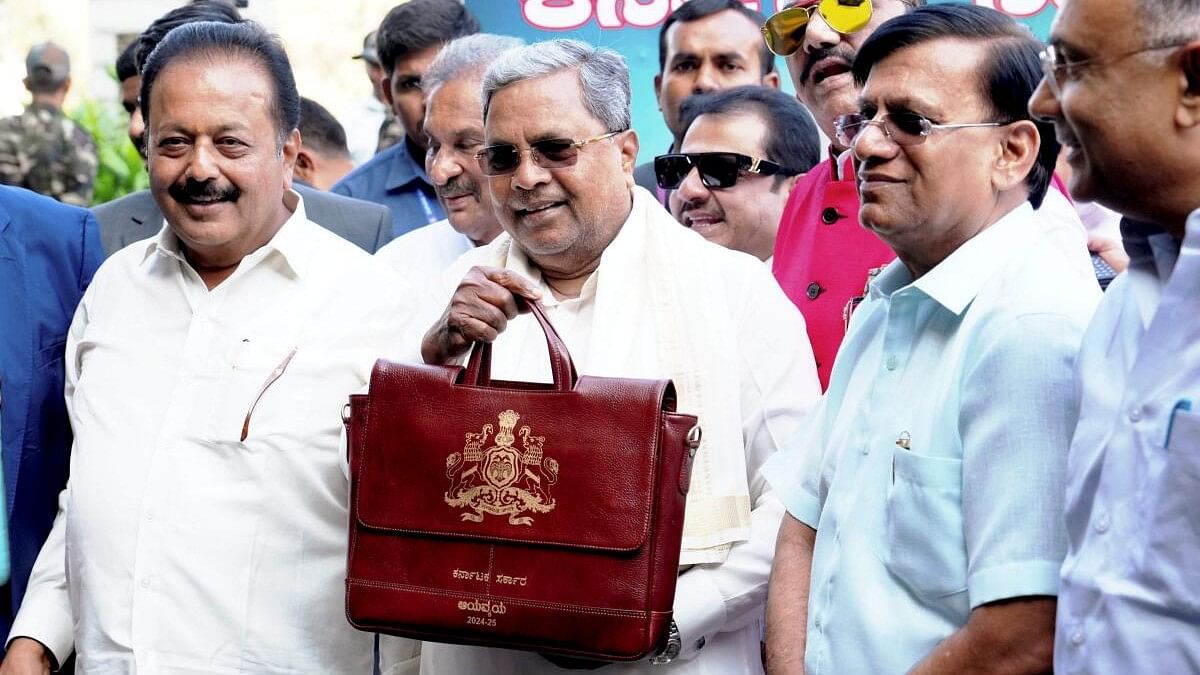
Karnataka Chief Minister Siddaramaiah with a bag containing budget papers arrives at Vidhana Soudha, in Bengaluru
Credit: PTI Photo
Karnataka Chief Minister Siddaramaiah has a reputation as a prudent finance minister of the state, but the constraints he is facing now are evident in the budget proposals for 2024-25 presented by him in the Assembly on Friday.
Though, as the Chief Minister himself says, the state is in good financial health, he has estimated a revenue deficit of Rs 27,354 crore for the coming fiscal as against Rs 13,951 crore last year. In contrast, his predecessor Basavaraj Bommai had presented a Rs 400-crore revenue surplus in his interim budget in February 2023. What’s weighing down Siddaramaiah, who incidentally presented the state’s first revenue-surplus budget many years ago, are the five guarantees or electoral promises implemented by his government, which are estimated to consume Rs 52,000 crore.
This has left very little room for manoeuvring. However, Siddaramaiah has managed to keep the fiscal deficit at 2.95 per cent of the GSDP, and thus within the 3 per cent cap prescribed by the Karnataka Fiscal Responsibility Act, 2002. While the Chief Minister has promised that the state will once again have a revenue surplus in the next two years, a concrete action plan or indication of a pathway for achieving the same is missing, save for a proposal to increase excise revenue to Rs 38,000 crore, as against the present collection of about Rs 28,000 crore, by rationalising duty slabs. Instead, the government should have thought of new revenue streams, such as boosting income from tourism.
The Chief Minister has apportioned blame for the state’s distress to the Centre, accusing it of denying Karnataka its rightful share of tax revenue. The state had, he noted, lost Rs 59,274 crore due to “unscientific” implementation of GST and another Rs 62,000 crore due to lower devolution of tax revenues to the state.
The Centre has also failed to release special grants of Rs 11,596 crore recommended by the Finance Commission. Despite this, Siddaramaiah said, he had set aside Rs 1,20,373 crore for welfare projects.
Another worrying factor is the 1.8 per cent negative growth of the agriculture sector due to drought, while the service sector, which is the biggest contributor to the state exchequer, grew by 8.7 per cent and the industrial sector by 7.5 per cent. The budget could have incorporated some proposals to step up manufacturing to shift surplus labour in the agriculture sector while the latter revives.
Some of the highlights include consolidation of various farmer schemes, setting up of ‘Kisan Mall’, providing record crop loans to farmers, Rs 850 crore for school infrastructure, and the eternal promise of developing Bengaluru into a world-class city. While the budget may not have proposed anything extraordinary, Siddaramaiah has managed to keep the five guarantees going, proving wrong critics who had predicted that the government would not be able to sustain these schemes for long.